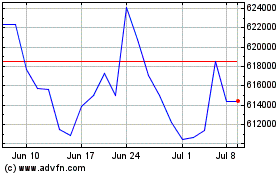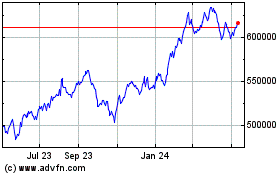By Nicole Friedman
The myriad companies of Warren Buffett's Berkshire Hathaway Inc.
have run completely independently of each other for decades. That
isn't always the case any longer.
Top executives from Berkshire units now gather regularly to
share strategies and best practices. Some of these companies
participate in purchasing cohorts to take advantage of group rates
for items like travel and raw materials. Last year, employees from
more than 40 Berkshire businesses met in the firm's headquarters
city of Omaha, Neb., to discuss sustainability.
The rise in internal collaboration, which executives rarely
discuss publicly, hints at what the firm might look like when Mr.
Buffett is no longer running it as chairman and CEO.
Last year the company's subsidiary CEOs started reporting to Mr.
Buffett's lieutenants, Ajit Jain and Greg Abel, rather than to Mr.
Buffett. And at the subsidiary level, roughly one-third of
Berkshire's business units have announced a new CEO in the past
five years as an older generation of managers has retired or
stepped back into chairman roles.
"Even though we're in different industries and have different
business models, there's so much that connects us," said Mary
Rhinehart, CEO of Berkshire's building-products maker Johns
Manville. "Why wouldn't we take advantage of the talent across the
Berkshire Hathaway organization?"
While many other conglomerates combine departments and seek
savings when they buy businesses, Berkshire historically hasn't.
Its home builder Clayton, for example, isn't required to buy bricks
from Berkshire's Acme Brick. But Berkshire companies now are
communicating and working together more than ever, thanks largely
to efforts begun in 2013.
Starting that year, Berskhire's 60-odd CEOs began meeting yearly
in Omaha to discuss common challenges like cybersecurity and
hiring. Tracy Britt Cool, Mr. Buffett's former financial assistant
and the CEO of Berkshire unit Pampered Chef, organized the first
roundtable.
Collaboration among Berkshire companies "is grass roots," Mr.
Buffett said in an interview last week. "I'm certainly glad to see
it, but I don't promote it."
Mr. Buffett seeks to buy well-run companies and leave them
alone, allowing Berkshire CEOs to set their own strategies, pay
plans and employee benefits. Berkshire's subsidiaries employ nearly
390,000 people around the world, and before the roundtables, many
Berkshire CEOs hadn't met each other in person.
"The best cooperation is voluntary," Mr. Buffett said. "That's
not a change in the culture, though. It's sort of a sign of the
culture. It really is people thinking like owners and exercising,
in a sense, their independence."
Separate from the annual roundtables, there is also now a
Berkshire Hathaway Sustainability Summit that has grown from 37
attendees representing 24 Berkshire businesses at the first summit
in 2013 to about 140 participants from more than 40 Berkshire
companies and their subsidiaries at last year's event. In addition,
a group of sustainability-focused employees at various Berkshire
companies speak about once a month to share ideas and
strategies.
There are also formal networks for Berkshire CFOs and for
executives in areas including human resources and
cybersecurity.
The sustainability summits grew out of informal conversations
among some subsidiaries, said Susan Farris, vice president of
sustainability and corporate communications at Berkshire's carpet
and flooring company, Shaw Industries Group Inc., which hosted the
first event in 2013.
"With a group of Berkshire companies, there's a significant
level of comfort that you might not have attending a broader
conference," she said. "We share priorities and values."
Purchasing groups, which allow subsidiaries to take advantage of
Berkshire's scale, grew out of the CFO meetings more than a decade
ago, Ms. Rhinehart said.
Some Berkshire businesses overlap with each other and even
directly compete for customers. Berkshire owns four furniture
companies, four jewelry companies and a variety of insurance units.
In addition, a number of Berkshire companies operate in the housing
and construction industries, including Shaw, Clayton, paint maker
Benjamin Moore & Co. and real-estate brokerage firm
HomeServices of America.
"It's not as if there's a weekly or quarterly call with
[housing] industry participants," said Jeff Pederson, CEO of CORT,
Berkshire's furniture-rental company. "But the nice thing about the
group of men and women that Warren has is they're all so very
willing to lend a hand."
One aspect of Berkshire that could become more centralized in
the future is health care.
Haven, Berkshire's health-care joint venture with Amazon.com
Inc. and JPMorgan Chase & Co., is in its early stages but aims
to reduce health-care costs for the three companies' employees.
That could mean requiring Berkshire units that currently buy their
own health insurance to change their strategies.
Meantime, current Berkshire executives have already tapped into
the CEO network. Dan Calkins, who started as Benjamin Moore's CEO
in January after 32 years with the company, called another
subsidiary's manager in late 2018 to learn how that unit sets its
compensation and incentives for senior executives.
See's Candies CEO Brad Kinstler, who has worked at three
Berkshire subsidiaries, said last year that the annual CEO meetings
have sparked new working relationships.
"It used to be more just individual contacts that you would
have," said Mr. Kinstler. Now, "there's an open exchange of ideas
on a number of different things, and I think it's very
helpful."
Write to Nicole Friedman at nicole.friedman@wsj.com
(END) Dow Jones Newswires
April 04, 2019 05:44 ET (09:44 GMT)
Copyright (c) 2019 Dow Jones & Company, Inc.
Berkshire Hathaway (NYSE:BRK.A)
Historical Stock Chart
From Mar 2024 to Apr 2024

Berkshire Hathaway (NYSE:BRK.A)
Historical Stock Chart
From Apr 2023 to Apr 2024
